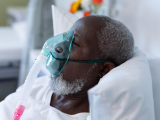An analysis of 7 million contacts of COVID-19 patients in the United Kingdom estimates that most transmissions resulted from exposures lasting 1 hour to several days and that households accounted for 40% of spread from spring 2021 to early 2022.
A team led by University of Oxford researchers evaluated data from the National Health Service (NHS) COVID-19 contact-tracing smartphone app in England and Wales to estimate how well app measurements correlated with real-life transmissions.
Using Bluetooth signal strength and 240,000 positive COVID-19 tests, the NHS notified the contacts of confirmed patients of exposures from April 2021 to February 2022 and recorded data on whether contacts also tested positive. The results were published today in Nature.
"Contacts—individuals exposed to confirmed cases—were notified according to public health policies such as the 2-metre [6.6 feet] 15-minute guideline, despite limited evidence supporting this threshold," the study authors wrote. "Contact tracing apps are useful for public health if they are able to estimate the risk of pathogen transmission and should be evaluated to improve their functionality and ensure public trust."
Better exposure guidelines could mean less disruption
Empiric metrics and statistical modeling revealed a strong relationship between app-computed risk scores and the likelihood of real-life transmission. The odds of transmission confirmed by a positive COVID-19 test initially climbed in a linear fashion with exposure duration (1.1% per hour) and continued to rise over several days.
Most exposures were short (median, 40 minutes), but transmission usually resulted from exposures of 1 hour to several days (median, 6 hours; 82% lasted longer than 1 hour).
With sufficient preparation, privacy-preserving yet precise analyses of risk that would inform public health measures, based on digital contact tracing, could be performed within weeks of a new pathogen emerging.
Longer exposures at greater distances carried similar risk as shorter exposures at closer distances. Households made up roughly 6% of contacts but accounted for 40% of transmissions.
"We demonstrate that the NHS COVID-19 app accurately translated proximity and duration of exposure into a meaningful epidemiological risk score, and we quantify how these factors affected the actual probably of transmission," the authors wrote.
The social and economic costs of nonpharmaceutical mandates for physical distancing, testing, contact tracing, and quarantine could have been reduced by better guidelines for contact tracing and quarantine, the researchers said. For example, contact tracing would have been less disruptive and still have identified 80% of contacts if the duration guideline were 1 hour or more rather than 15 minutes.
"Optimizing such interventions requires methods to quantify transmission risk factors," they wrote. "With sufficient preparation, privacy-preserving yet precise analyses of risk that would inform public health measures, based on digital contact tracing, could be performed within weeks of a new pathogen emerging."



















